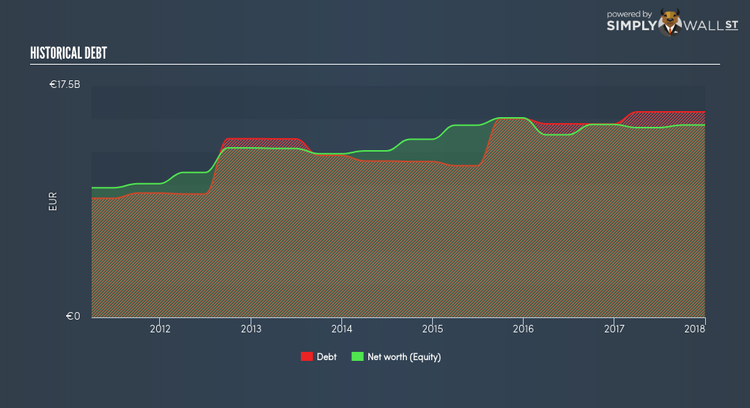Is Heineken NV. (AMS:HEIA) A Financially Sound Company?

Heineken NV. (ENXTAM:HEIA), a large-cap worth €49.11B, comes to mind for investors seeking a strong and reliable stock investment. Market participants who are conscious of risk tend to search for large firms, attracted by the prospect of varied revenue sources and strong returns on capital. However, the health of the financials determines whether the company continues to succeed. Today we will look at Heineken’s financial liquidity and debt levels, which are strong indicators for whether the company can weather economic downturns or fund strategic acquisitions for future growth. Note that this commentary is very high-level and solely focused on financial health, so I suggest you dig deeper yourself into HEIA here. Check out our latest analysis for Heineken
How much cash does HEIA generate through its operations?
HEIA has built up its total debt levels in the last twelve months, from €14.60B to €15.51B – this includes both the current and long-term debt. With this growth in debt, HEIA’s cash and short-term investments stands at €2.44B , ready to deploy into the business. On top of this, HEIA has produced €3.88B in operating cash flow during the same period of time, resulting in an operating cash to total debt ratio of 25.02%, meaning that HEIA’s current level of operating cash is high enough to cover debt. This ratio can also be a sign of operational efficiency as an alternative to return on assets. In HEIA’s case, it is able to generate 0.25x cash from its debt capital.
Does HEIA’s liquid assets cover its short-term commitments?
Looking at HEIA’s most recent €10.46B liabilities, the company has not been able to meet these commitments with a current assets level of €8.25B, leading to a 0.79x current account ratio. which is under the appropriate industry ratio of 3x.
Can HEIA service its debt comfortably?
Since equity is smaller than total debt levels, Heineken is considered to have high leverage. This is not unusual for large-caps since debt tends to be less expensive than equity because interest payments are tax deductible. Accordingly, large companies often have an advantage over small-caps through lower cost of capital due to cheaper financing. We can check to see whether HEIA is able to meet its debt obligations by looking at the net interest coverage ratio. A company generating earnings before interest and tax (EBIT) at least three times its net interest payments is considered financially sound. In HEIA’s case, the ratio of 8.33x suggests that interest is appropriately covered. Large-cap investments like HEIA are often believed to be a safe investment due to their ability to pump out ample earnings multiple times its interest payments.
Next Steps:
HEIA’s high cash coverage means that, although its debt levels are high, the company is able to utilise its borrowings efficiently in order to generate cash flow. However, its lack of liquidity raises questions over current asset management practices for the large-cap. I admit this is a fairly basic analysis for HEIA’s financial health. Other important fundamentals need to be considered alongside. You should continue to research Heineken to get a more holistic view of the stock by looking at:
Future Outlook: What are well-informed industry analysts predicting for HEIA’s future growth? Take a look at our free research report of analyst consensus for HEIA’s outlook.
Valuation: What is HEIA worth today? Is the stock undervalued, even when its growth outlook is factored into its intrinsic value? The intrinsic value infographic in our free research report helps visualize whether HEIA is currently mispriced by the market.
Other High-Performing Stocks: Are there other stocks that provide better prospects with proven track records? Explore our free list of these great stocks here.
To help readers see pass the short term volatility of the financial market, we aim to bring you a long-term focused research analysis purely driven by fundamental data. Note that our analysis does not factor in the latest price sensitive company announcements.
The author is an independent contributor and at the time of publication had no position in the stocks mentioned.


